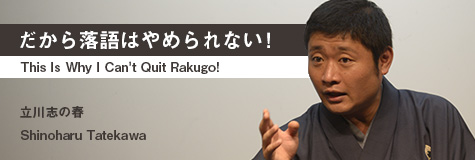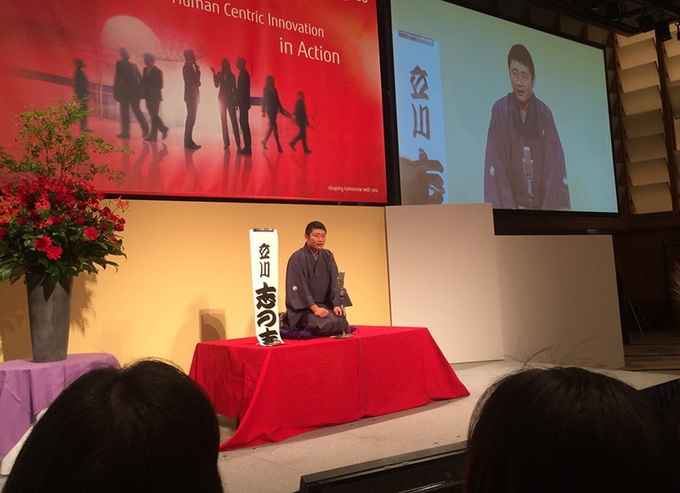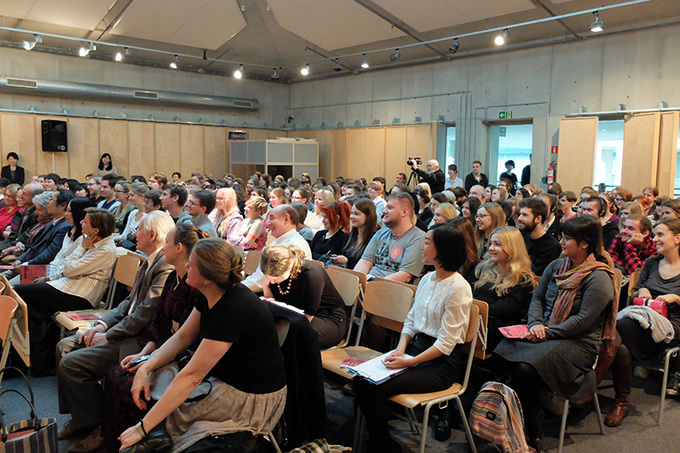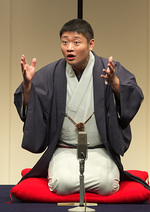
4. The Appeal of Classic Rakugo Stories can be Sufficiently Conveyed in English
Shinoharu Tatekawa
The early summer (shoka) is upon us. How have you been holding up? I am a chirographer (shoka), Shinoharu Tatekawa.*1 Wait, that's not it. I'm a rakugo performer Shinoharu Tatekawa. The Golden Week at the beginning of May passed so quickly, but may-be you all are having a great time.
The last one wasn't good taste, was it?
Sorry to hit you with a series of lame puns right from the very beginning, but the truth is, these kinds of puns and wordplay are not very comprehensible when translated into English. I am not sure whether they are comprehensible in Japanese either, but that's another issue altogether.
In April and May, I had several opportunities to perform rakugo in English at international schools and various events, so this time I would like to write about performing rakugo in English.

Performing rakugo in English at a buffet party at the Fujitsu Forum on May 14
Many of you probably have doubts whether rakugo is comprehensible at all in English.
Below is a literal translation of the introduction to a traditional rakugo story. The exchange between the two characters is similar to throwing a jab in boxing. It is impossible to translate into English. Take a look:
"Hello, old man!"
"Oh is that you Hattsuan? Come on in."
"Wow, thanks for the treat."
"What do you mean, thanks for the treat?"
"Well, you just said, 'Have some rice,' old man."
"No, I didn't say 'Have some rice,' I said 'Come on in!'"
This exchange makes you wonder what's the matter with Hattsuan. How can anyone mistake "come on in" with "have some rice"? It makes no sense. The only possible reaction would be to suggest that Hattsuan needs to have his hearing checked.
That is why I have no choice but to quickly skip over such puns when performing rakugo in English. This, however, does not mean that rakugo stories by themselves are incomprehensible.
When performing in front of a foreign audience, I start by explaining the concept of rakugo.
"Rakugo is a traditional Japanese performing art. It has some similarities with the Western stand-up comedy genre, but the performer is sitting. In other words, rakugo is traditional Japanese stand-up-but-sit-down comedy."
"What? How does that work?"
"The performer is wearing a kimono and sitting on a cushion called zabuton as he performs using just two props--a folding fan and a hand towel. The fan and the hand towel are transformed into chopsticks, swords, wallets, or letters."
"Wow! Magic!"
"No, no. They are not really transformed. It just happens in your imagination."
This is how I explain the basics first, and then begin my performance.
My experience shows that this approach works, and I really do get the stories across the audience. Moreover, I get them across exceptionally well. Almost every time. Actually, I do it so well that I am beginning to think I just might be a genius. In fact, my performances in English can make audience laugh about 300 times better than the performances I deliver in Japanese.
Naturally, this is a synergy effect of the novelty of rakugo as a comedy genre foreigners encounter for the first time and the gap with their image of ordinary Japanese people. Nevertheless, I am very happy when the audience understands rakugo stories well.
Classic rakugo stories have "survived" nearly 300 years. Surely that's an amazing thing, isn't it? It means that today we laugh at the same things at which people laughed 300 years ago. This proves such laughter is universal. Therefore, classic rakugo stories also have the power to cross the sea and transcend cultural differences within the same period.

A lecture and rakugo performance as part of a Lecture Program organized by Mitsui & Co. Ltd. at the University of Warsaw, Poland
It may be impossible to properly convey puns and wordplay into a foreign language. Their original flavor may get lost in the translation. Yet, there are so many elements of rakugo that can be conveyed through the laughter nurtured since the time of the Edo period. I intend to continue performing rakugo in English in a way that will properly convey these elements without damaging their original flavor.
I would be quite exasperated if I am told that Japanese are no fun. This is why.
*1: Shoka (初夏early summer) and shoka (書家chirographer) are homophones.
 Shinoharu Tatekawa
Shinoharu Tatekawa
Rakugo performer Shinoharu Tatekawa was born in Osaka in 1976 and raised in Kashiwa, Chiba Prefecture. After graduating from Yale University in the U. S., he began working at Mitsui & Co. in 1999. In his third year of work, he chanced upon a performance by Shinosuke Tatekawa. It had such a huge impact on him that he made the decision to become a rakugo performer after half a year, upon much deliberation. He approached Shinosuke Tatekawa directly to accept him as a disciple, but was rejected. However, he then resigned from his job and entreated the master once again to accept him as a disciple. In October 2002, he was accepted as the third disciple of Shinosuke Tatekawa. In January 2011, he was promoted to futatsume (the second highest rank). He performs classical and contemporary rakugo works, as well as rakugo in English, and has even performed in Singapore. In 2013, he received an encouragement prize from the Nikkan Tobikiri Rakugo Kai. His publications include Dare demo Waraeru Eigo Rakugo: Rakugo in English [Rakugo that anyone can laugh: Rakugo in English] (Shinchosha) and Anata no Purezen ni "Makura" wa Aruka? Rakugo ni Manabu Shigoto no Hinto [Does your presentation have an "introduction"?] (Star Seas Company). His latest publication is Jibun wo Kowasu Yuki [Courage to destroy yourself] (CrossMedia Publishing).
*Please visit the official websites below for information about his live performances.
Shinoharu Tatekawa's official website http://shinoharu.com/
Shinoharu Tatekawa's blog http://ameblo.jp/tatekawashinoharu/
Back Issues
- 2022.7.27 Beyond Disasters - T…
- 2022.6.20 Beyond Disasters - T…
- 2021.6. 7 Contributed Article …
- 2021.4.28 Crossing Borders, En…
- 2021.4.27 Contributed Article …
- 2021.4.20 Contributed Article …
- 2021.3.29 Contributed Article …
- 2020.12.22 Interview with the R…
- 2020.12.21 Interview with the R…
- 2020.11.13 Interview with the R…

